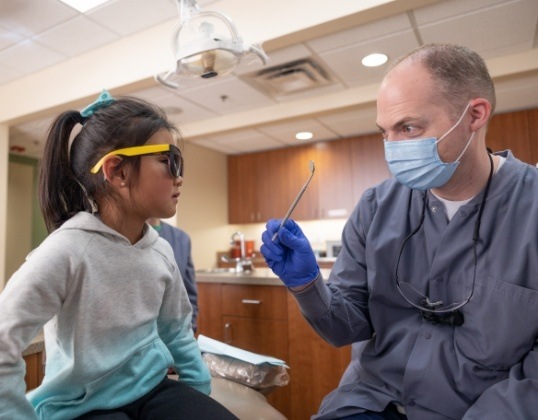Pulp Therapy – Castle Rock, CO
Saving Teeth Damaged by Decay

Is your child experiencing pain caused by decay that has spread to the inner part of their tooth? When bacteria and decay reach the nerve or “pulp,” it can cause extreme discomfort and inflammation. This is why Castle Rock Smiles Pediatric Dentistry offers pulp treatment to address the problem and save the tooth. Children are often more prone to cavities and tooth decay because of their lack of being diligent in practicing good oral habits. However, our team of pediatric dentistry experts can use pulp therapy to treat and restore the affected tooth before it’s too late. To find out more about this type of restorative dental care, or to have your child be seen by one of our dental professionals, contact us to schedule an appointment for pulp therapy in Castle Rock, CO.
Why Choose Castle Rock Smiles Pediatric Dentistry for Pulp Therapy?
-
 Gentle Dentists Who Listen
Gentle Dentists Who Listen
to Your Child’s Needs -
 Multiple Sedation Dentistry
Multiple Sedation Dentistry
Options Available -
 Personalized Restorations
Personalized Restorations
to Protect Treated Teeth
What is Pulp?

The pulp is located in the center portion of your tooth. Comprised of various nerves, tissue, and blood vessels, it can be extremely painful if damaged by decay. Although adults are just as susceptible to tooth decay, it appears in children more often because of their usual lack of brushing and/or flossing. Additionally, our children are always running and playing, making it more likely for them to experience injury to their teeth, which can also affect the pulp of a tooth.
What Are Some Signs of Bad Pulp?

Although pulp cannot be seen, and you or your child may not know immediately if damage has occurred, within a short amount of time, it will be quite evident that your child needs to see a pediatric dentist. At Castle Rock Smiles Pediatric Dentistry, we tell our patients to look for the following when determining if a pulp injury has occurred:
- Unexplained pain that remains constant
- Pain that occurs throughout the night
- Sensitivity to warm or cold temperature (food or beverages)
- Unexpected loosening of the tooth
- Swelling around the affected tooth or redness appearing
How is it Treated Through a Pulpotomy in Children?

When treating an inflamed nerve caused by decay, there are essentially two approaches we can take: an indirect pulp cap or a pulpotomy. Our pediatric dental office performs a pulpotomy to save the tooth and get your child the relief they need from the pain.
Essentially, every child’s dental needs are different. In all cases, Dr. Benzley will try to save the tooth from extraction. This is because missing or extracted teeth in children can result in unfortunate consequences, including:
- Remaining teeth might shift to fill in the gap area.
- If a primary tooth is lost, their permanent tooth may not have enough space to emerge.
- Their premolars might become impacted and cause extreme pain.
This is why it’s always best to have our pediatric dentist examine your child’s affected tooth and determine if pulp therapy will be the best course of action.
During a pulpotomy, Dr. Benzley will remove all or part of the pulp (nerve) of the tooth above the portion where the nerve extends into the root of the tooth. Then, he will apply medication to the lower part of the pulp chamber, allowing the nerve to maintain its vitality and prevent further infection. He’ll go on to fill the tooth and if necessary, place a crown to protect and strengthen the tooth’s structure.
Pulp Therapy FAQs
How Much Pain is Normal After Pulp Therapy?
Your child’s mouth will be numbed with a local anesthetic before their treatment begins. We also offer sedation options to help them feel even more comfortable in the dental chair. Ultimately, they shouldn’t be able to feel a thing during the procedure itself. After the numbness wears off, they may experience some soreness or sensitivity, but this is mild and temporary. Any discomfort can be managed with over-the-counter pain relievers. After a few days, their smile should feel good as new!
Can My Child Eat Before Pulp Therapy?
If your child is receiving sedation for their pulp therapy, they may need to fast for a few hours before their treatment. This helps to reduce the risk of nausea caused by the sedative. If your child isn’t receiving sedation, having a meal a couple of hours before their procedure is a good idea because they will need to wait until after the numbness has worn off before they can eat again.
What Happens if You Wait Too Long for Pulp Therapy?
Unlike the rest of the body, the teeth are unable to heal themselves. This means that tooth infection will only get worse, and more painful, if it isn’t treated. Your child’s pulp therapy should be scheduled as soon as their dentist says that they need it. Waiting too long for this procedure can cause the infection to spread to other areas of the mouth, resulting in systematic illness. The tooth can even become so damaged that it needs to be extracted.
Can Pulp Therapy Be Prevented?
The best way to prevent the need for pulp therapy is to help your child keep up an excellent oral hygiene routine. This means brushing twice and flossing every day. They should also attend cleanings and checkups twice a year with their dentist. Maintaining a healthy diet also helps to prevent oral health issues. This means limiting sugar, eating lots of nutritious foods, and staying hydrated. If your child plays sports, purchase them a mouthguard to keep their teeth protected.







